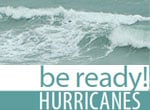Lightning Information for Beach and Water Activities

Learn steps you can take to protect yourself and your loved ones from lightning while participating in water activities.
- Check the forecast
Before leaving for the beach or any water activity, such as a boating trip, check the weather forecast so you know what to expect during the day. If the forecast is for thunderstorms, plan your trip for another day. - Go indoors
Remember the phrase, “When thunder roars, go indoors.” If you hear thunder while you are at the beach, find a safe, enclosed shelter, such as your car. Do NOT seek shelter under beach picnic shelters. - Listen to the forecast
It is crucial to listen to weather information when you are at the beach or boating. Short-term forecasts are quite accurate, but sometimes miss some very localized storms. - Learn how to read the weather
Watch for the development of large, well-defined rising cumulus clouds. Cumulus clouds have flat bases and dome or cauliflower shapes. Cumulus clouds can develop into thunderstorms. Once the clouds reach 30,000 feet, the thunderstorm is generally developing, and it is time to head for shore. As clouds become darker and more anvil-shaped, the storm is already in progress. - Watch and listen for distant storm activity
Watch for distant lightning and listen for distant thunder. You might hear thunder before you see lightning on a bright day. If you hear thunder or see lightning, seek shelter away from the water. - If you are out in the open water and a storm rolls in, return to shore immediately
If you are on a boat in open water when a thunderstorm rolls in, return to shore immediately and seek shelter. Once on land, get at least 100 yards away from shore. If you are unable to return to shore, boats with cabins offer some protection. When inside the cabin during a lightning storm, stay away from all metal and electrical components, including the radio, unless it is an emergency. If caught in a storm in a small boat with no cabin, drop anchor and get as low as possible. - Protect your boat
The National Ag Safety Database provides a number of ways you can protect your boat and minimize damage if it is struck by lightning or is near a lightning strike.
Page last reviewed: June 7, 2022


